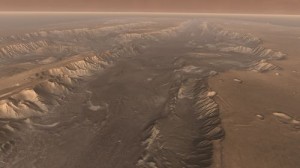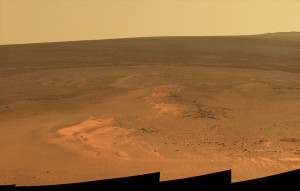The state of our exploration of Mars can be described as follows:
- We are still wrestling with the results of experiments done by the two Viking landers that visited Mars in 1976.
- We are fascinated by the numerous detailed images our robotic orbiters have taken of the planet’s surface. We see familiar things in land patterns that suggest the presence of water recently and in the past.
- We are measuring atmospheric seasonal changes that suggest either a chemical or biological change is occurring impacting the composition of the air from winter to summer and back again.
In the second decade of the 21st century Mars is more a puzzle than understood. The question our Martian adventure is getting close to answering is this: Is Earth the sole planet where living things exist? And we are getting closer to this answer without ever setting a human foot on the planet’s surface. Instead our Martian studies have involved a series of robotic missions loaded with scientific instruments. These missions have included orbiters, robotic landers and rovers. The information we have gleaned from these incredible machines has painted a picture of Mars that is altering our perspective of what constitutes a planet capable of harboring life. Let’s look at some of the technology that has gotten us to this point.
From Odyssey to Spirit and Opportunity
Odyssey
Aptly named Mars Odyssey after Arthur C. Clarke’s novel, 2001: A Space Odyssey, NASA launched this robotic mission to the planet in April 2001. Its primary mission focused on studying the Martian atmosphere, surface and subsurface using three scientific instrument packages named THEMIS, MARIE and GRS. THEMIS was designed to study active thermal occurrences on the Martian surface in order to detect surface minerals by their spectral fingerprint. MARIE was designed to study the radiation from cosmic rays not only in the vicinity and surface of the planet but throughout the interplanetary space between Earth and Mars. GRS was designed to study Martian chemistry using gamma ray and neutron detectors. Odyssey arrived at Mars in October 2001 and entered orbit on the 24th. Its original mission was designed to end in August 2004. The spacecraft continues to operate on an extended mission more than a decade after its arrival.
The Odyssey mission has given us a better picture of both the planet and what a human mission would experience in travelling there. The results of MARIE sampling indicates that humans travelling between Earth and Mars would experience twice as much exposure to cosmic rays as humans on the International Space Station.

We also have learned from THEMIS that Mars polar ice caps unleash gas jets of CO2 every spring, that the Martian surface has extensive chloride salt deposits left behind when large bodies of liquid water evaporated, that the atmosphere can churn up dust storms and dust devils similar to those found in deserts on Earth, that at least one large crater, Aram Chaos, was once a lake, and that the planet has extensive water-eroded channels on its surface. From GRS data we have detected evidence of substantial subsurface ice as well as deposits of iron, silicon and potassium.
Spirit and Opportunity
In 2004 two robotic spacecraft arrived on the surface of Mars to deploy two rovers, Spirit and Opportunity. The mission for both rovers packed with scientific instruments was to last 90 days with the objective to explore the Martian terrain, study its geology, look for evidence of water in the past and present and relay images back to Earth receiving stations. Solar power and batteries have provided the power to all the instrumentation and cameras.
Deployed at landing sites on opposite sides of the planet both rovers exceeded expectations with Spirit the first to succumb to the harsh Martian environment as it became trapped in soft Martian terrain in spring of 2009, eventually falling silent during the winter of 2010.
Opportunity, however, continues to chug along as of May 2012, a remarkable feat of technological engineering supported by a dedicated team of Earth based scientists who continue to devise new experiments and missions for the rover.

What both Spirit and Opportunity discovered shortly after landing included significant evidence that Mars was once a wet environment and that the evidence in the rocks shows that the planet has experienced wet and dry periods throughout its geological history. While on the Martian surface Opportunity has far outpaced its sister rover, Spirit (7.7 kilometers or 4.8 miles before getting stuck) accumulating a total driving distance of 34.4 kilometers (21.4 miles). To experience a portion of Opportunity’s remarkable journey access the video created by the science support team’s piecing together of end-of-day images taken by the rover as it travelled almost 21 kilometers (13 miles) between the Victoria and Endeavour Craters on the planet’s surface.
Opportunity’s current location is on the edge of Endeavour Crater assignment where it is hunkered down in its fifth Martian winter. Acting as a stationary observation platform it is conducting a study of the interior of the planet using radio-tracking to measure any wobbles as the planet rotates. A significant wobble will indicate whether Mars has a molten core or not. As Martian spring and summer unfold Opportunity will resume its trek, an amazing accomplishment.
The story of our exploration of Mars will continue in our next Space and Humanity in the 21st Century blog.








